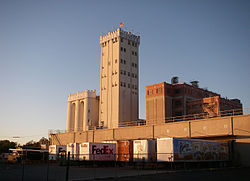C.H.Guenther personal life and background
Carl Hilmar Guenther (1826–1902) was one of eight children born to millwright Carl Gottfried Guenther and his wife Johanne Rosina Koerner Guenther on March 19, 1826, in Weißenfels, Germany. Like his father, he had been trained to be a millwright, and in 1844 became a member of the guild of master millwrights in Europe. [2] He also had trade skills as a cabinet maker and stonemason. [3] In 1848, Guenther traveled to the United States. [4] Guenther declared his intention to become a United States citizen on June 28, 1851. Citizenship was granted to him on October 8, 1854. [5] He became a Justice of the Peace in 1856. On October 7, 1855, Guenther married Dorothea Pape. [6] The couple had seven children. [7]
Emigration to Texas
Guenther's first visit to the United States was in 1848 through the port of New York with a sojourn in Wisconsin before returning to Germany. Three years later, Guenther returned through Indianola, Texas, at the time a major entry port for German immigrants. [8]
Gillespie County
He relocated southwest of Fredericksburg at Live Oak Creek, near the present site of Lady Bird Johnson Municipal Park, [9] and began constructing his dream of a gristmill. His steam-operated mill was built with imported French millstones. Inclement weather conditions came close to washing away the unfinished mill in a flood. Nevertheless, Guenther persevered and completed what would become known as Pioneer Flour Mills, a wheat and corn operation that served the area residents of Gillespie County. [3]
San Antonio
Recurring periods of alternating floods and drought prompted Guenther in 1859 to reassess his situation. After seeing the need for mills to serve San Antonio's growing population, Guenther made the decision to move his base of operations there [2] [10] The site for his new mill would be on land directly adjacent to what became known as the King William Historic District.
King William District home
Guenther's home was one of the first built in the King William neighborhood. He began construction of his vernacular native limestone home in the district at King William and Guenther streets. The stones were quarried in the area that now is Brackenridge Park, and wood used in the construction was East Texas pine. The original entrance to the house faced southward towards the mill. A 1915 expansion of the house, changed the entrance to the north side, fronting the San Antonio River. The original entrance now serves as a hallway between the museum and the River Mill Store part of the house. [3] [11] The top floor of the house is known as the Roof Garden and once hosted dances. The space is currently used for large meetings or luncheons. The south side of the house now has a patio and arbor for outdoor dining.
An area of the house that once served as the library, is now the museum containing family keepsakes, as well as artifacts of milling, dining and baking history in San Antonio. Travel souvenirs from around the world are also part of the museum. The museum, store and restaurant are open to the public 7 days a week. [12]
This page is based on this
Wikipedia article Text is available under the
CC BY-SA 4.0 license; additional terms may apply.
Images, videos and audio are available under their respective licenses.






